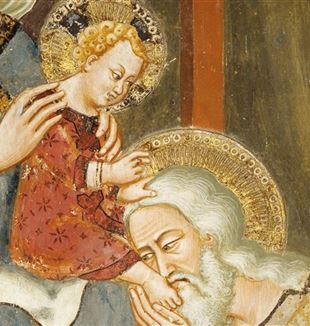
The caress of the Child Jesus
The small hand resting on the head of one of the Magi bowed down to adore him. This is the heart of the image chosen this year for the Communion and Liberation Christmas poster.The Child rests his small hand on the white-haired head of the king who kneels at his feet. This is the detail that most strikes and moves us in this depiction of the Adoration of the Magi painted by an anonymous master around 1330 at the Sacro Speco in Subiaco. We are in the Chapel of the Madonna, an architectural environment that was aggregated at the beginning of the 14th century to that extraordinary complex built around the grotto inhabited by Saint Benedict during the years of his hermitage, between 497 and 500. The walls are completely frescoed with the stories of Mary by two masters from a very similar artistic sphere, whom recent studies have associated with the Umbrian school: Giovanni, the prior of the Sacro Speco monastery in those years preceding the great plague of 1348, came from Perugia. On the wall to the right of the altar below a representation of the Annunciation, we find two panels of the Nativity and the Adoration of the Magi in a logical sequence. Both are set under the protection of a canopy, supported on slender wooden pillars: almost a metaphor for the ciborium that in many churches, especially in the Middle Ages, covers and protects the altar and thus the place where Christ is physically present in the Eucharist.
Read also - Christmas 2023: The CL poster
The anonymous artist from Subiaco had a precise prototype in mind: that of Giotto in the Scrovegni Chapel, who in the scenes relating to the Nativity erects a humble little temple in front of the opening of the grotto. Not even thirty years had passed since the completion of the Paduan site, but evidently the novelty of that masterpiece was such that it soon went viral. The Subiaco Master had certainly become familiar with the solution devised by Giotto for the Adoration of the Magi, because in the Chapel of the Madonna he replicated the master's solution, turning the scene around by 180 degrees. From the Padua fresco comes the idea of the elder king kneeling down and kissing the feet of the Child, who in turn is held in Mary’s arms. She is elevated, seated on a throne that is invisible to us. Thus, a diagonal line is drawn between the three protagonists of the scene. In his simplicity, the Subiaco Master accentuates this motif through a more profile view. The effect is that of a whole, where hands function as the tender link between the figures. Starting from the bottom, there are those of the King, who brings the Child's foot to his mouth to kiss it; then there are those of the baby Jesus, who with his right hand makes a gesture of blessing and with his left hand caresses the King's head; finally, those of the Mother, who holds the Child and at the same time seems to caress him.
Great prototypes are also such because they always a space of freedom to those who replicate them. This is what happens in the passage of this image from Padua to Subiaco, where the anonymous master has added the element of the Child's gestures, when instead Giotto had presented the little Jesus completely wrapped in swaddling clothes, his body real and firmly present. In front of the solidity of that model, the Child seems here to be carved into the space of the fresco with Gothic grace. But since the Master has left his hands free, he can move us with that unexpected, tender and simple gesture. We can perceive it as a first form of his feeling of pity that embraces all men – including kings – of which Fr. Giussani speaks in the passage that accompanies this image.